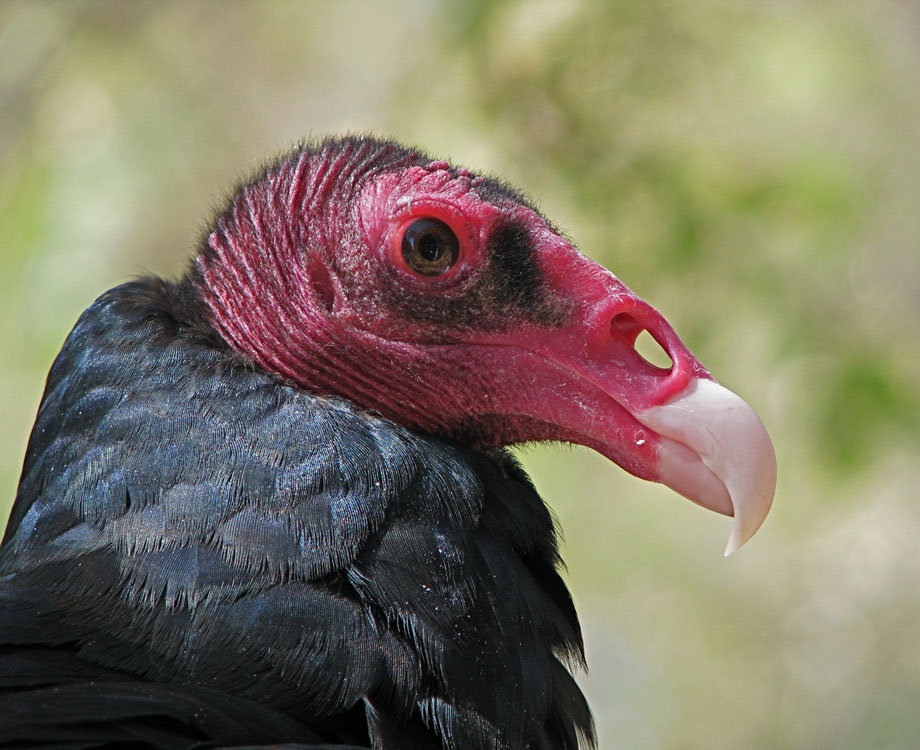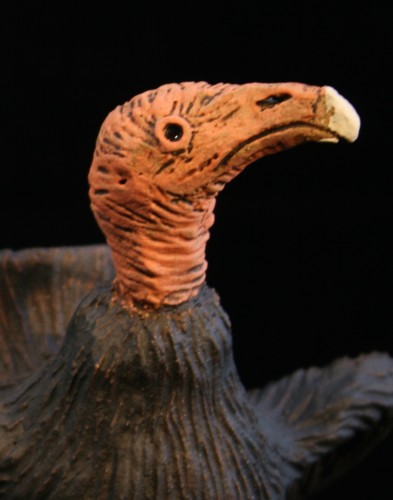The pervious nostril: why vultures don’t need kleenex
An excellent feature of Turkey vultures is see-through nostrils. That is, they lack a septum, so the opening to their sinuses goes straight through the top of their beak. This is handy for an organism which eats its meals  with its head in the liquescent innards of dead things. With just a quick sneeze, any annoying clogging matter can be ejected. Also, the free passage of air into the sinuses enables the scent of lunch to be picked up even from an altitude of several hundred feet.
with its head in the liquescent innards of dead things. With just a quick sneeze, any annoying clogging matter can be ejected. Also, the free passage of air into the sinuses enables the scent of lunch to be picked up even from an altitude of several hundred feet.
The pervious nostril can be easily seen in the photo above (by E. Shock). If this vulture were chilly it would keep warm by pulling his feathery neck-ruff up to his ears by corrugating his forehead skin even more.
The “pervious nostril” is a characteristic of the New World Vultures (the Cathartids: Turkey, Black, and King vultures, the Lesser and Greater Yellow-headed vultures, and both California and Andean condors) and like their bare facial skin is a physical characteristic most likely related to their ancestry: genetic studies have shown they are possibly more closely related to storks than to the Old World vultures and other birds of prey.
I t goes without saying that the pervious nostril, as being indispensable to the visual character of the organism, is always faithfully reproduced in Three Star Owl vulture items such as candle-holders (seen to the right, as well as in the Three Star Owl Shop) and a small vulture bottle.
t goes without saying that the pervious nostril, as being indispensable to the visual character of the organism, is always faithfully reproduced in Three Star Owl vulture items such as candle-holders (seen to the right, as well as in the Three Star Owl Shop) and a small vulture bottle.
Etymology: If you grew up calling Turkey vultures “buzzards” as many Americans do, you are using a word translplanted here by European English-speaking settlers. There are no vultures in the British Isles, but there are hawks, which are called “buzzards”. When newly arrived Europeans saw our big vultures circling overhead, they used the word they had always used for raptors. The “Turkey” part of the common name “turkey vulture” comes from the fact that at a distance turkey vultures, which like wild turkeys spend a lot of time on the ground, look like turkeys, being of a similar size, with dark body plumage and having colorful bare heads.

[…] to note the Pervious Nostril! Click here for more […]